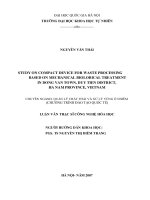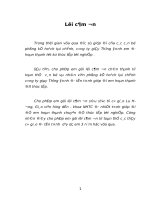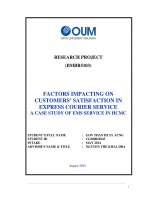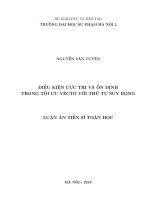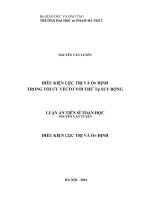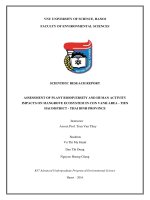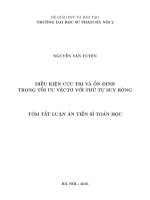Changing trend and the factors impacting on ritual practice of Xơ Teng people in Tu Mơ Rông commune and district, Kon Tum province
Bạn đang xem bản rút gọn của tài liệu. Xem và tải ngay bản đầy đủ của tài liệu tại đây (67.83 KB, 10 trang )
26
Changing trend and the factors impacting on…
Changing trend and the factors impacting on ritual
practice of Xơ Teng people in Tu Mơ Rông commune
and district, Kon Tum province
Phạm Thị Trung
MA., Kon Tum Department of Culture, Sports and Tourism
Email:
Received 29 July 2017; published 25 August 2017
Abstract: One of the core elements which have contributed to making the image and
identity of every ethnic group is the belief. It is so because the faith and practice of belief
reflect the worldview, philosophy and behaviour of ethnic group towards nature and
society. However, in the trend of integration, globalization and active urbanization as today,
the beliefs of local ethnic minorities of Central Highlands in general, and of Xơ Teng people
of Xơ Đăng ethnic minority living in 8 villages Tu Mơ Rông commune and district of Kon
Tum province in particular, have changed considerably by intermixed and complicated
diversification, impacting on preserving and bringing into play the ethnic cultural identity.
This paper focuses on understanding the changing trend and the factors impacting on the
changes in practice of belief of Xơ Teng people in Tu Mơ Rông commune today(*) .
Keywords: Belief, Change of belief, Xơ Teng people, Xơ Đăng ethnic minority.
1. Some belief characteristics of Xơ Teng
people in Tu Mơ Rông)
- Conception of universe: According to
traditional conception of Xơ Teng people,
(*)
Xơ Teng people are a local ethnic group within Xơ
Đăng ethnic minority, one of seven ethnic minorities
in Kon Tum. Up to Dec 2016, Tu Mơ Rông
commune has 336 households, mainly of Xơ Teng
people, settled in 8 villages, among which there are
two Catholic villages. The data of this paper are the
results of field survey of author and of the “Report
on socioeconomic and defense-security situations of
2016 and plan for 2017” of Tu Mơ Rông commune.
the universe consists of 6 storeys: “Pai rap
pleng / Pai rap tơ nei” (three storeys in sky
/ three others on earth). The six storeys of
universe are divided into three worlds such
as: the Heaven World (Răp Pho - the World
of Bo Bo seed) that consists of two storeys
which are the storey of Thunder God (xieng
Tơ Ro) and the storey of two parallel gods
Noa - Ja; the Middle World (Răp Phi - the
world of rice grain), that is the world of
humankind, of ghosts, of demons and
deities; the Lower World (Răp Pơ Lá - the
world of broken rice grain) that consists of
27
Social Sciences Information Review, Vol.11, No.2, June, 2017
three storeys which are storey of water god,
storey of Pơ lá people and storey of Man
layer of Lower World. Thus it can be seen
that the conception of universe of Xơ Teng
people has a certain difference in comparison
with other local ethnic groups in Central
Highlands, that was generally referred to by
a French scholar in the work Miraculous
Land. This scholar showed that the universe
of Xơ Teng people consists of “seven
complete systems” (Dam Bo, 2003: 409).
- Conception of gods and spirits: The
system of deities of Xơ Teng people
consists essentially of gods such as: thunder
god, moon and sun god, god of banian tree,
water god, Ya Ka Đo god (the god of
childbirth),... According to Xơ Teng people,
the system of deities is not divided yet into
ranks. Besides that, in conception of Xơ
Teng people, there are also other spirits,
like ghosts for example.
- Conception of human souls: Xơ Teng
people conceive the humans as being
modelled in mud by Ya Ka Đo god, each
human having six souls. Xơ Teng people
have no idea of metempsychosis and
conceive that the soul is not immortal but
disappeared after a certain time cycle. It can
be said that this is one of the original
features of faith of Xơ Teng people upon the
soul, while most nations, especially the less
developed communities, believe in
eternality of souls, that they can return to
reincarnate or metamorphose into another
form after death (E. Durkheim, 1968: 227).
Conception of universe, deities, souls as
mentioned above shows that the traditional
belief system of Xơ Teng people in Tu Mơ
Rông commune in the past and today is
quite rich, represents deeply the polytheistic
belief and the belief that the soul is all
things. The characteristics of these beliefs
are expressed in traditional rites such as: 1)
The rites related to professions, like
choosing mountain field, clearing up the
field, burning off field for cultivation, rice
pruning, superfluous rice eating, first rice
eating, depot rice eating; the rite of buffalo
stable worship, the rite of praying for rain,
the rites related to hunting and forging; 2)
The rites related to community such as:
village gate worship, flume worship,
communal house worship, village change
worship; 3) The rites related to life cycle of
human as follows: ceremony of initiation,
ceremony of passage to adulthood, wedding
ceremony, sacrificing buffalo to pray for
health, for peace, to drive evil ghosts away,
to pray for the sake of soul; ceremony of
funeral (sky burial funeral, ordinary death
funeral, evil death funeral); the kơ nă
ritual;... In general, these basic features of
traditional beliefs and rites of Xơ Teng
people were so far referred to by some
studies, particularly by the sudy of Ngọc
Anh (1960), of Nguyễn Kinh Chi and
Nguyễn Đổng Chi (1937), of Võ Chuẩn
(1993), and of A Tuấn (2015),... However,
the trend of change and the factors
impacting on this changing trend of today’s
belief of Xơ Teng people are still less
interesed.
2. Changing trend in practice of traditional
beliefs of today’s Xơ Teng people
- Trend to lose some traditional rites: The
studies showed that the traditional rites in
practices of belief of Xơ Teng people today
have lost their ancient perfect whole. Many
rituals have disappeared and this situation
is common in all villages, especially in the
two catholic villages. There are some
examples of these lost rituals: sky burial and
Changing trend and the factors impacting on…
evil death funeral. Some important rites like
kơ nă ceremony also are not held by those
of two Catholic villages. Some rituals rich
in traditional cultural ethnic identity and
high communal coherence such as flume
worship, village gate worship and village
change worship... are no longer practised in
the villages like Tu Mơ Rông, Văn Sang and
Đăk Neng. Some professional rituals have
disappeared such as mountain field choice,
clearing up and burning off the field for
cultivation, forge worship, buffalo stable
worship, especially the ceremony of “buffalo
eating”, a meticulous ceremony of traditional
sacrifice that is not practised in the Catholic
villages now.
- Trend to flexibility and simpleness in
belief practices: This trend is manifested in
flexibility of time in traditional belief
practices. According to ancient rules, the rites
of profession, of personal or communal life
cycle, all are related to each other and have
to be held in conformity with certain steps,
that is, one might not hold the ceremony of
communal house worship if there had not
previously held the superfluous rice eating
and if in village there are still households that
had not held the ceremony of kơ nă ritual, but
now the ceremony of communal house
worship may be held at any time of year,
right after the communal house is newly
constructed or repaired. Previously, it might
not hold the ceremony of village gate
worship and ceremony of sacrificing buffalo
to pray for health before having cleared up
the field and burned off field for cultivation,
but now these two rituals have the trend to
come close to the time of traditional New
Year’s Day;... Thus, the systematic and
principled order of organization of traditional
rites has changed considerably. While in the
28
past the organization of rites non-conforming
to the prescribed times was strictly
prohibited, now in the new conditions, the
times of rites are moved to be more suitable
to requirements of contemporary life. But,
there is a concern that if the time of
organization of rites is not reasonable, then
the now flexibility of time may lead to the
considerable fading of people’s faith and
values of traditional belief.
The time frame of rite organization is also
flexible in the direction of simpleness. For
example, the ceremony of initiation for a
child is not necessarily practised on the
third day after birth as previously, but if the
child is born at hospital or if the mother
and baby are not healthy..., then their
family may organize this ceremony later.
Similarly, in the past, the wedding was
held only after the ceremony of first rice
eating and after the ritual of opening rice
depot, but now wedding may be held at
every time of year; the rites of village gate
worship, flume worship, buffalo sacrifice...
were previously practised in a whole
month long, but now they are reduced to
some days.
The trend to simplification is also manifested
through the changes of worship oration. In
the past, the worship oration was represented
in verses, having rhythm and poetic
resonance, crystallized in aesthetic and
rhetorical values, but now it becomes simple,
announcing only the motive of organization
of ceremony and the wishes which are to be
prayed for. The decoration of ceremony is
also simplified, having almost no traditional
clothes.
- Trend to secularization of belief practices:
First, there is a phenomenon of changing
over from traditional belief in the role of
29
Social Sciences Information Review, Vol.11, No.2, June, 2017
supernatural power to scientific explanations.
For example, in the past, the whirlwind
usually was seen as the action of lady-god
Ka đo rô ve, and the phenomenon of
landslide in rainy months was considered
as the actions of interminable war between
various powerful mountain god villages...,
but today many people see them as natural
phenomena; previously, the exploitation of
natural sources of benefit might be
effectuated under the rituals to pray for
fortune, but today, the hunting and logging
are seen as usual jobs to satisfy the needs
of human beings.
In traditional society, festival is a special
moment of spirit, a space and time favour
for humans to make contact with deities in
order to pay their honour and admiration
and pray to divine powers for the wishes of
their own, their family and community. The
characteristics of traditional ritual space are
not as the same as previously. For example,
in the past, the sacred space of a house is
expressed by a system of signs consisting of
the New Year pole/tree (cây nêu), the
decorative fringe, the meticulously prepared
offerings, but now this space is in essence
like the ordinary space, except the New
Year tree, other components being sparsely
decorated. The secularity is also expressed
by the fading of taboo practices in festival
space; the shows as festivities and as wishes
of fortune have almost disappeared in
rituals today.
- Trend to restore the traditions and absorb
new factors of belief: Along with policy of
restoration of traditional festivities in order
to contribute to preservation and promotion
of cultural values, many festivals are
studied and restored. Some festivals are
organized with scenarios and restoration by
State agencies; the others are restored by
local cultural entities themselves in
communal environment. The restoration of
festivals has had certain impacts on
awareness of cultural entities, especially
the youth, giving them the chance for more
understanding communal culture, promoting
their trust and love for ethnic cultural values.
Through exchanging and contacting with
other ethnic cultures, the belief and belief
practices of Xơ Teng people have the trend
to absorb new components such as: the
ceremony of life cycle is changing in the
way of combining the traditional ceremony
of initiation with ceremony of first birthday
anniversary (one-year-old anniversary); the
ceremony of full moon celebration and
celebration of birthday of Kinh people are
adopted; some families make the altar,
settling the picture of the dead and incenseburner at home;... The adoption of new
components into rituals is also manifested
by introduction of new offerings into
worship such as: rice vodka, money and
other modern utensils. The Catholic villages
have some changes in religious beliefs by
adopting in addition some certain new
belief practices in accordance with Catholic
faith, such as: organizing ceremony of
cleaning up the graves annually on
November, making confessions in the rite
of initiation of baby,...
3. Factors impacting on the changes of
belief today
- Impacts of process of changing economic
structure: The traditional economic
structure of Highlands in general and of Xơ
Teng people in Tu Mơ Rông commune in
particular basically is still the economy of
mountain field cultivation. However, after
more than 30 years since the VIth Congress
Changing trend and the factors impacting on…
of Vietnam Communist Party (1986), the
renovation work has brought significant
changes to these lands, especially to the
economy of Xơ Teng people along with
movement of country.
First of all, there appears the diversity of
types of economic ownership; the village’s
ownership of lands and forest is reduced,
while the personal and household
ownerships of these resources have the
trend to increase, but not satisfying yet the
requirements of a traditional mode of
production based on exploitation of natural
resources. Therefore, although not suffering
the pressure of immigrants for seeking new
economy and free immigrants to Highlands
in recent years, but the traditional economy
of mountain fields is still impacted by the
change of ownership and it fast changes.
This fact impacted obviously on the
preservation and promotion of cultural
values of belief life of people, especially the
agricultural belief.
Essential economic activities of Xơ Teng
people in Tu Mơ Rông commune today are
still agricultural production. Therefore, the
agricultural land area is very high, being
about 1,485 ha, making up 26.33% of total
natural land area of commune. In recent
time, Tu Mơ Rông commune has deployed
many projects of changing crop plants and
domestic animals, increasing productivity,
leading to change the economic structure
and crop land area, according to which the
mountain rice lands have been reduced,
instead of which there being the lands for
productive manioc, hybrid maize and
industrial crops like rubber tree, coffee tree,
bollywood tree,... Up to 2016, mountain
land area is about 34.3 ha, while manioc
land area occupies 150 ha, 103 ha being
30
wet rice land, the rest is area of other shortterm industrial crops. Thus, the people have
participated in production process of
commodities, being no longer pressed by
the old habit of accumulation of foods;
many traditional material values being also
broken; similarly, the traditional exchange
activities also changing considerably.
Especially, since 1986, the district towns,
inter-communal towns or centres have been
developed, so the traditional way of
communication with Laos and Quang Nam
province to the south of Xơ Teng people has
been closed. Today they only go down to
Kon Tum city for shopping and exchanging
products when having real needs, because
all the towns, the communal and intercommunal centres and even villages have
shops for them to buy things and products
of Kinh people, satisfying the basic needs
of local people, leading their material life to
change more and more, with new introduced
value system that has contributed to change
and complete the old values,... Hence, the
scale of festivals, together with other cultural
characteristics of Xơ Teng people, have
progressively changed. For example, in the
past, the evaluation of personal and family
positions within community were based on
number of precious gongs, old jars and
economic potential of a household sufficient
for usual organization of buffalo sacrifice...
but today these conditions have been
replaced by other ones such as: the solid
house, TV set, motorcycle, telephone,...
These changes of conditions for people to
satisfy their living in modern society have
brought many opportunities for human
development, but the most interesting risk
here is that people little by little forget
traditional cultural values that have
31
Social Sciences Information Review, Vol.11, No.2, June, 2017
constituted their ethnic identity to adopt unadequately the new components.
- Impacts of the changes of natural
environment: The model of economic
development of the Highlands in general
and of Tu Mơ Rông commune in particular
is the growth in the width, mainly based on
investment capital of State, on assistance
from outside, on exploitation of local
natural resources in an unreasonable
economic structure with very low quality
human resources. The promotion of natural
potential for economic development in
recent time has created and is creating the
great “pressure” of natural environment on
the sustainable development of this region,
because all economic activities here are
related to the use and exploitation of lands,
especially to the change of forest land into
industrial crop land,... The development of
industrial crops in large area and settled on
mountain slope is one of the facts causing
the erosion and degeneration of soil, the
devastating floods, the considerable
reduction of forest and ecosystem at Tu Mơ
Rông area,... This means that the natural
environment for certain traditional beliefs
has disappeared, because the traditional
communal fund of lands was reduced, and
the technique of alternating the crops on
mountain slope was replaced by fixedly
settled cultivation, then the rituals related to
old cultivation conditions have also
disappeared. Forests surrounding village
that play the role of buffer zone, with many
socioeconomic, defence and security
functions and with natural beneficial
sources for community, have now
disappeared, so the rites related to these
forests are no longer practised. The sacred
zones are usually seen as exploitable zones;
the massive exploitation of forest products
recently has strongly impacted on the belief
that “the soul is all things” and on the
polytheism of Xơ Teng people, so today
they exploit the forest products without
practising the rites and respecting the taboos
as previously, because they think “surely
there are no longer gods here”, they even
exploit the forests at upper sources, at
cemeteries without any fear, while in the
past these acts were the taboos.
- Impacts of the changes of state
management institutions and family model:
According to current administrative
division, the village complex of Xơ Teng
people is divided into different hamlets and
groups as follows: Tu Mơ Rông village is
divided into three groups, Đăk Chum IInd
village is split into two hamlets as Đăk
Chum IInd and Đăk Chum IIIrd,... Without
being in a common village, each group and
each hamlet have their own relatively
independent activities, so the role and
influence of village patriarch have effects
only in the group and hamlet where he lives.
While for ancient Xơ Teng people, although
having a common original village, but if
their divided hamlets were settled separately
from each other and no longer sharing the
same water source, then they are not be seen
as the same villagers... Thus, the ancient
tight coherence of village community has
faded. Therefore, coming to the village of
Xơ Teng people today, one can find no
longer the sacredness of the village gate,
where previously were statues of heros
guarding the peace of community; the
habits related to common fate of village
community do not necessarily oblige the
individuals to participate; there are no
sufficient human resources and materials for
Changing trend and the factors impacting on…
constructing the communal houses, so these
houses little by little lose their previous
grandiose magnificence, now being left as
“small as a storehouse of my family in
olden times” (after the words of Mr. A Sớm,
an old man of Đăk Chum IInd hamlet).
Similarly, the long house of a Xơ Teng
family now is divided for various nuclear
families. Although the habits related to
settlement formality in long house are still
kept, but the young married couples always
like to live separately into nuclear families.
The household splitting has dispersed the
inherent human resources of long house and
the economic potential serving the rites,
causing the original but costly ceremony of
buffalo sacrifice to be a big problem for
nuclear family.
- Influences of outside religions and
beliefs: With the guideline of enlarging the
God’s country, Catholicism came to
Vietnam in about XVIth century, but only
after 3 centuries later it penetrated into the
region of Ba Na and Xơ Đăng peoples in
Kon Tum, having been associated with the
names of various French priests such as
Kueno, Michen, Duelos,... The period
from the end of XIXth century to the
beginning of XXth century is a period of
strong development of Catholicism of Xơ
Đăng people in Đăk Tô region, with the
names of parishes and Catholic villages,
like Diên Bình, Tân Cảnh Kon Ho Ring,
Đăk Chờ,... In 1960s, in the region of Xơ
Đăng people there exist 20,312 Catholic
believers (Priest Gioakim Nguyễn Hoàng
Sơn, 2013), with two villages of Văn Sang
and Đăk Neng in Tu Mơ Rông commune,
being representative for the belief change
of Xơ Teng people from traditional belief
to Catholic belief before 1975. The
32
presence of Catholicism here was and is a
factor that has had great influence on
belief life of Xơ Teng people.
It is easy to see that in the two Catholic
villages there are many changes of
traditional cultural activities, such as the
abolishment of traditional ceremony of
sacrifice, because the blood of animals is
no longer considered as symbol of life, of
proliferation; the ritual system related to
human soul is also not practised as
previously, that is, instead of praying Jă Ka
Đo god to give a soul to baby, the family
prays God the Father for this favour; the
agricultural rites that have high communal
coherence are still maintained annually,
like ceremony of celebrating the first rice
harvest that is held not in fixed time in the
traditional villages, while in Catholic
villages it is fixed periodically on 25
October annually; The New Year tree in
traditional belief was always associated
with festival of buffalo sacrifice, but in
festival of the two Catholic villages today,
this New Year tree is raised as a decorative
thing, giving the aesthetic effect to
common festival of village. The gongs in
cultural traditions were associated with the
rites related to buffalo sacrifice, but now in
the Catholic villages they are simply the
traditional music instruments, possibly
being played in any occasion of family or
community, like in: wedding, celebration of
new house, celebration of first rice...
without obedience to old prescriptions. The
Catholics still participate in common rituals
of community and do not refuse to eat
sacred offerings, but they make excuses for
not practising the ritual of moisturizing
with the sacred blood,... This situation
expresses somewhat the integration of
33
Social Sciences Information Review, Vol.11, No.2, June, 2017
Catholicism into local traditional culture
when it was imported in spiritual life of Xơ
Teng people.
- Impacts of exchanges and acculturation in
the context of development and
international integration: In today general
trend of the world to integration and
globalization, the cultural exchanges
between regions, areas, ethnic groups are
actively developing. The fact that
inter-communal centre is at the same time
the district capital, both settled in Tu Mơ
Rông commune from 2005 to 2010, is a
favourable condition for cultural exchanges
between Xơ Teng people and other ethnic
groups, especially the Kinh people. Besides
that, the development of media channel
system such as radio station, television,
internet... has contributed to break the
seemingly separate space of olden Tu Mơ
Rông region, opening the conditions for
access to values of other cultures. Now
100% of hamlets and villages have
loudspeakers of communal radio and
television station; most families have TV set
for access to new information and cultural
fluxes; smartphone and internet connection
are significant channels in service of
cultural penetration, especially for the
young;... The inter-ethnic marriage and
fluxes of the young leaving village for study
and job are also “bridges” to bring the new
cultures into local lands. These phenomena
lead to change belief awareness in general
and traditional belief practices in particular.
- Subjective factors of cultural entities: In
deploying the policies of socioeconomic
development for mountain rural area, the
administrators are usually concerned about
a great challenge that a part of people
became passive, with an expectant attitude.
Therefore the “entity” factor is seen by
many as a problem for sustainable
development, but the reality shows that the
movement of Xơ Teng people in current
society is faced by the problem of gradual
degradation of internal forces, while being
strongly impacted by the forces of many
external factors.
First of all, it can be seen that the oral
transmittance and live performances are
making the inherent strong internal vital
forces of traditional beliefs risk weakening
in modern social conditions. It is because
that now all of the things have fast
penetrated into daily life, among which
there are modern and useful techniques,
while the influences of old men in today Xơ
Teng villages are considerably narrowed
gradually. That’s why, the transmittance and
reception of faith and of belief practices
from generation to generation are degraded,
disrupted. On the other hand, belief is a
social phenomenon, changing incessantly
with society, so while the other religions
incessantly develop their dogmas and their
erudite missionaries, but the folk-beliefs of
Xơ Teng people have not these advantages.
The traditional faith does not make the
changes and complements corresponding to
satisfy the spiritual needs of people in the
face of social evolutions; the intellectual
standards of Xơ Teng people are still low,
so they quite lack those intellectuals who
would know deeply the beliefs and the role
of traditional beliefs in order to be able to
orientate the belief activities of communities
and individuals.
Together with that, the awareness of
people themselves on precious cultural
heritages is still insufficient; the values of
traditional beliefs are not satisfactorily
Changing trend and the factors impacting on…
understood. Therefore, today there are more
and more people who think that
organizing rituals with buffalo sacrifice is
obsolete and costly; precious gongs and jars
are sold or exchanged for useful utensils for
the living needs of individuals and families,
so in all the Tu Mơ Rông commune now
remain only 12 gong sets (3 sets with 12
gongs and 9 sets with 7 gongs); the
communal houses are no longer decorated
with sacred things of village such as drums,
gongs, jars, sacrificed buffalo heads, big
hunted animal bones… but instead of these
there are the slogans, banners and
contemporary certificates of merits of
hamlet or village; the inner space of house
on stilts of a family is also no longer
decorated with gongs, jars, drums and
worshiping pole... that previously exposed
the position and pride of family head; it is
also illusionary if someone wants to see
here the image of old men in loin-cloth, of
old women with naked chest, with precious
stone necklace under the white hair, sitting
in peace to “eat tobacco”;… These abovementioned evolutions show that, those men
who can keep the link between present and
tradition have also been changed; the clash
between the past and the present has
somewhat broken the image of primitive
mountain area of Tu Mơ Rông with original
cultural values; the fact that many cultural
components in the past are hard to refind
has contributed to create a certain gap and
missing in these lands and people.
4. Some comments instead of conclusions
Studying the belief life of ethnic groups in
Vietnam is always one of subjects that
interests many scientists. The results of
studies not only contribute to point out the
traditional cultural physiognomy, but also
34
more clarify the changes and trend of
movement of belief practice in modern
society. The research results on belief of
Xơ Teng people in Tu Mơ Rông commune
show that this field has many deep human
cultural values, reflecting especially the
unity of ethnic communal consciousness,
nurturing the communal coherence,
contributing to preservation and promotion
of ethnic cultural identities, satisfying
spiritual needs of every individual and
community,... However, the impacts of
economic changes, of the change of social
institutions and ecologic environment,
have led and are leading to the deep
changes of belief life of this ethnic group
in both the form and contents, among
which, essential changes are manifested in
gradually losing certain conceptions and
rituals of belief as well as simplifying the
traditional worship rituals.
This changes are to satisfy the spiritual
needs corresponding to contemporary
socioeconomic development and be
chosen by Xơ Teng people themselves. But
thisreality has somewhat caused the
cultural disruption between tradition and
modernity, impoverishing the cultural human
values of individuals and communities in
belief conception as well as in traditional
belief practices. Therefore, real situation is
putting a demand that the appropriate
authorities must continue to carefully study,
deeply understand the belief needs of people
in order to build the policies, solutions and
models of practising spiritual life
corresponding to local reality, contributing to
preservation and promotion of traditional
belief values in service of today more
effective construction of new rural areas for
Xơ Teng people community
35
Social Sciences Information Review, Vol.11, No.2, June, 2017
References
1. Ngọc Anh (1960), “Brief introduction
on Xơ Đăng ethnic minority”, Ethnic
Bulletin (Tập san Dân tộc) (13), Hanoi.
2. People’s Committee of Tu Mơ Rông
commune
(2016),
Report
on
socioeconomic and defence-security
situations of 2016 and plan for 2017,
Kon Tum.
3. Nguyễn Kinh Chi, Nguyễn Đổng Chi
(1937), Kon Tum Ethnic Minorities, Hue.
4. Võ Chuẩn (1993), “Kon Tum
provincial records”, Review of Nam
Phong, No. 191.
5. Dambo (2003), Miraculous Land,
Vietnam
Writers
Association
Publishers, Hanoi.
6. E. Durkheim (1968), The Elementary
Religious
Activities,
Translated
document, stored at Library of Institute
for Ethnology, Hanoi.
7. Priest Gioakim, Nguyễn Hoàng Sơn
(2013), “Missionary Centre of Kontrang
for Sơđang people”, Parish of Kon Tum.
8. Ngô Đức Thịnh (ed., 2001), Belief and
Belief Culture in Vietnam, Social
Sciences Publishing House, Hanoi.
9. Ngô Đức Thịnh (ed., 2007), On Belief
and Traditional Festivals, Culture and
Information Publishing House, Hanoi.
10. A Tuấn (2015), “Communal Rituals of
Xơ Teng People in Tu Mơ Rông
District, Kon Tum Province”, PhD
thesis in culturology, Graduate
Academy of Social Sciences, Hanoi.

